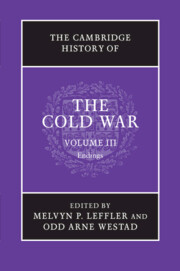Book contents
- Frontmatter
- 1 The Cold War and the intellectual history of the late twentieth century
- 2 The world economy and the Cold War, 1970–1990
- 3 The rise and fall of Eurocommunism
- 4 The Cold War and Jimmy Carter
- 5 Soviet foreign policy from détente to Gorbachev, 1975–1985
- 6 Islamism, the Iranian revolution, and the Soviet invasion of Afghanistan
- 7 The collapse of superpower détente, 1975–1980
- 8 Japan and the Cold War, 1960–1991
- 9 China and the Cold War after Mao
- 10 The Cold War in Central America, 1975–1991
- 11 The Cold War and southern Africa, 1976–1990
- 12 The Gorbachev revolution and the end of the Cold War
- 13 US foreign policy under Reagan and Bush
- 14 Western Europe and the end of the Cold War, 1979–1989
- 15 The East European revolutions of 1989
- 16 The unification of Germany, 1985–1991
- 17 The collapse of the Soviet Union, 1990–1991
- 18 Science, technology, and the Cold War
- 19 Transnational organizations and the Cold War
- 20 The biosphere and the Cold War
- 21 The Cold War and human rights
- 22 The Cold War in the longue durée: global migration, public health, and population control
- 23 Consumer capitalism and the end of the Cold War
- 24 An ‘incredibly swift transition’: reflections on the end of the Cold War
- 25 The restructuring of the international system after the Cold War
- Bibliographical essay
- Index
- References
20 - The biosphere and the Cold War
Published online by Cambridge University Press: 28 September 2010
- Frontmatter
- 1 The Cold War and the intellectual history of the late twentieth century
- 2 The world economy and the Cold War, 1970–1990
- 3 The rise and fall of Eurocommunism
- 4 The Cold War and Jimmy Carter
- 5 Soviet foreign policy from détente to Gorbachev, 1975–1985
- 6 Islamism, the Iranian revolution, and the Soviet invasion of Afghanistan
- 7 The collapse of superpower détente, 1975–1980
- 8 Japan and the Cold War, 1960–1991
- 9 China and the Cold War after Mao
- 10 The Cold War in Central America, 1975–1991
- 11 The Cold War and southern Africa, 1976–1990
- 12 The Gorbachev revolution and the end of the Cold War
- 13 US foreign policy under Reagan and Bush
- 14 Western Europe and the end of the Cold War, 1979–1989
- 15 The East European revolutions of 1989
- 16 The unification of Germany, 1985–1991
- 17 The collapse of the Soviet Union, 1990–1991
- 18 Science, technology, and the Cold War
- 19 Transnational organizations and the Cold War
- 20 The biosphere and the Cold War
- 21 The Cold War and human rights
- 22 The Cold War in the longue durée: global migration, public health, and population control
- 23 Consumer capitalism and the end of the Cold War
- 24 An ‘incredibly swift transition’: reflections on the end of the Cold War
- 25 The restructuring of the international system after the Cold War
- Bibliographical essay
- Index
- References
Summary
Everything is connected to everything else.
V. I. Lenin (1914)When we try to pick out anything by itself, we find it hitched to everything else in the Universe.
John Muir (1911)The Cold War is one of the handful of subjects that can keep hundreds of historians busy all their lives. The literature already authored fills many a bookcase and website, with no end in sight. But little has been said about the environmental dimensions of the conflict. Perhaps for Cold War historians the fate of fish, forests, and so forth seems beside the point when examining an era replete with apocalyptic risks to humankind. It certainly seemed so to the great majority of people in power at the time. Meanwhile, of the squadrons of environmental historians at work on the years 1945–91, almost none have seen fit to link their work directly to the Cold War. This chapter will address some of the linkages between environmental change and the Cold War.
The analysis here focuses on three aspects: agriculture, especially the Green Revolution; transportation infrastructure, especially roads; and weapons production, especially nuclear weapons. Cold War geostrategic priorities shaped state efforts in these arenas, and those efforts brought significant, usually; unintended, environmental changes. Obviously, not all environmental change in the years 1945–91 should be attributed to the Cold War. Indeed, with a few exceptions, such as radioactive pollution from nuclear-weapons production and testing, the ecological tumult of the post-1945 era resulted from confluences of multitudes of causes, among which Cold War considerations normally played only a part.
- Type
- Chapter
- Information
- The Cambridge History of the Cold War , pp. 422 - 444Publisher: Cambridge University PressPrint publication year: 2010
References
- 3
- Cited by

